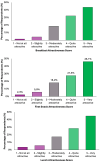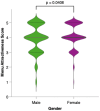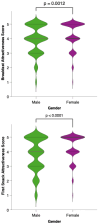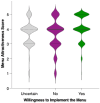Acceptability of a Colorectal Cancer-Preventive Diet Promoting Red Meat Reduction and Increased Fiber and Micronutrient Intake: A Cross-Sectional Study in Romanian Adults
- PMID: 40733011
- PMCID: PMC12300914
- DOI: 10.3390/nu17142386
Acceptability of a Colorectal Cancer-Preventive Diet Promoting Red Meat Reduction and Increased Fiber and Micronutrient Intake: A Cross-Sectional Study in Romanian Adults
Abstract
Background/Objectives: Colorectal cancer is a leading cause of cancer-related death worldwide, with rising incidence in younger adults. Unhealthy diets high in red and processed meat and low in fiber are key modifiable risk factors, highlighting the need for preventive nutritional strategies targeting CRC through dietary interventions. Methods: A one-day sample diet for colorectal cancer prevention, consisting of fiber-rich meals excluding red meat and incorporating whole grains, legumes, vegetables, fruits, nuts, and lean protein alternatives (such as fish and poultry), was developed. Its acceptability was assessed in a cross-sectional study using an online questionnaire among healthy Romanian adults aged 18-50, with a total of 395 included participants. Results: Of the 395 respondents meeting the inclusion criteria (aged 18-50, no cancer or chronic gastrointestinal disorders), 63.5% were females, predominantly urban (90.1%), and highly educated. Mean age was 32.4 years; mean BMI was 25.07 kg/m2. The proposed colorectal cancer-preventive diet was rated as "quite attractive" and "very attractive" by 74.9% of participants. All meals received high ratings, with dinner and the first snack being most favored. Most respondents (77.2%) found the diet satisfying and the satiety level and energy adequate, and 90.4% were willing to adopt it at least a few times per week. Financial accessibility was affirmed by 77.2% of the respondents. However, 61.8% reported difficulty eliminating red meat consumption. Female participants rated the diet significantly more attractive than males did (p = 0.041). Willingness to adopt the diet strongly correlated with higher acceptability (p < 0.0001), while BMI and education level showed no significant effect. Conclusions: The proposed colorectal cancer-preventive diet was well accepted by Romanian adults aged 18-50, with higher receptivity among women and those with higher education; willingness to adopt the diet at least a few days per week was high, especially among those psychologically ready for dietary change, while key barriers included red meat reduction and perceived cost, underscoring the need for gender-sensitive, culturally adapted interventions and further research on long-term adherence and clinical impact.
Keywords: colorectal cancer; diet acceptability; nutrition; preventive diet; primary prevention.
Conflict of interest statement
The authors declare no conflicts of interest.
Figures

















References
-
- American Cancer Society . Cancer Prevention & Early Detection: Facts & Figures 2025–2026. American Cancer Society; Atlanta, GA, USA: 2025.
MeSH terms
Substances
Grants and funding
LinkOut - more resources
Full Text Sources
Medical

